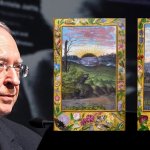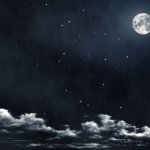
Daily Image for Tuesday, May 12, 2020
Special Edition
Art in a Time of Global Crisis: Interconnection and Companionship Project
In Celebration of Nurses and Caregivers Worldwide
Tuesday, May 12th is the 200 Anniversary of Florence Nightingale’s Birthday
Introduction from Ami Ronnberg, National ARAS Curator
“It was the creative light in Linda Carter’s mind that inspired us to honor nurses and all frontline caregivers who face into the shadows of suffering by offering an image representing the “Archetypal Nurse.” Our format is longer than usual today as we have recognized multiple layers of synchronistic confluence emerging now (including Mother’s Day) and we feel the timing is right to express our abiding gratitude to all who tend the sick with hope for health ahead.”
 Anna Marie Muench Mick, 1918-1919
Anna Marie Muench Mick, 1918-1919
Today, May 12th is Florence Nightingale’s birthday. Please take a moment to celebrate and offer thanks to nurses worldwide and to all healthcare givers and first responders who risk their lives daily to help provide for the well-being of all—especially at this extraordinary moment. Just as Florence, “the lady with the lamp,” led the way revolutionizing nursing and hospital practice, nurses have been dedicated to passing on the light of hope and compassion from the beginning of time and in every geographical location and society.
Please consider sending along this daily posting to those who are committed to caring for others as a kind of heartfelt “thank you note” for their dedicated service and let them know that they can sign on for supportive images and messages each day that will arrive in their email inboxes by clicking here or through the aras.org website.
Perhaps, a nurse will finish a night shift and find the new daily image on her cell phone and experience at least a moment of solace and companionship with those of us who are sending our gratitude and appreciation. Help them hold the lamp and the light in these dark times. Viruses are contagious but so is good will—pass it on.
Synchronistically, well before the current pandemic situation, The World Health Organization declared 2020 to be the “The Year of the Nurse and Midwife” in celebration of the 200th birthday of Florence Nightingale (1820–1910). The American Nurses’ Association (ANA) has designated May 6-12 as Nurses Week and May as Nurses Month to affirm and honor all who dedicate their lives to advancing the healthcare and welfare of people in every nation.*
The photograph above is of my grandmother, Nanna Mick who graduated from the West Jersey Hospital School of Nursing, Camden, NJ., in 1919 and worked endless hours and shifts throughout the Spanish flu epidemic while her fiancé (Charles my grandfather) was serving in the US Navy during WW I. My mother Barbara Mick Carter graduated from the same school of nursing in 1945 while my father (S. Thomas Carter) was on duty in the Navy at the end of WW II. My sister-in-law Mary Mulroy Carter followed and graduated from West Jersey in 1978. All of these brave women were young and were required to take classes, participate in rotating shifts “on the floor,” and live in the hospital while students. I began working at West Jersey as a Nurses’ Aide when I was 16. I am grateful to them and to all of the caregivers at West Jersey who so generously taught me about bedside care those many years ago and grateful for the many nurses who have surrounded and influenced my life from the beginning.
From these early roots, I was inspired and supported to go on for a BSN from Georgetown and MSN from Yale and finally to certification as an analyst with the IAAP. The imaginative drive for this current project also emerged, in part, from the values and service orientation of personal history tapping into the fundaments of the nurse archetype as an expression of the wounded healer.
The Art and Psyche Working Group* is grateful for the willingness of ARAS to partner, collaborate and make manifest this project as an expression of interconnection and companionship through art during a time world crisis.
Linda Carter
Carpinteria, CA
Lindacarter5066@gmail.com
_____________________________________________________
Translation
We publish each daily posting in English and the primary language of the author.
For those seeking translation into languages other than what is provided with the daily posting, consider using Google Translate at
Chinese:
To read the text in Chinese, you can copy the paragraph to a translation system named Tencent ( APP/websites) to translate the content as assistance.“如您无法阅读英文,可将段落复制到腾讯翻译君网址(https://fanyi.qq.com/)在线翻译,辅助理解” under the picture or paragraphs.
____________________________________________________
About the Project:
Art in a Time of Global Crisis: Interconnection and Companionship
Our Goal
ARAS and the Art and Psyche Working Group, in collaboration, have developed a new project, “Art in a Time of Global Crisis: Interconnection and Companionship,” as an international outreach through art.
Our goal is to create a network of mutual support through art during this difficult time. Colleagues and friends from around the world, representing various cultures, geographical locations and life-styles, have been invited to contribute artistic images with commentaries that represent companionship, resilience and hope in the face of threat, fear and struggle.
We plan to post one new offering each day (Monday-Friday) in our curated “virtual gallery.” With a consistent presence of art that expands with each new contribution, we hope to weave a web of interconnectedness during this current time of global upheaval. On this page you will find daily postings that will accrue and form an ever-growing collection that embraces art and soul.
_____________________________________________________________________
Brief Description of the Two Organizations Collaborating to Produce
Art in a Time of Global Crisis: Interconnection and Companionship
Daily Image Outreach Project
Art & Psyche is an unincorporated organization whose mission is to encourage the articulation of the symbolic essence of art in its many forms. Through conferences, presentations and the publishing of papers, it provides cross-disciplinary educational experiences with a depth psychological understanding to both members of the psychotherapeutic community and those in the art world. Every aspect of the development and production of the conferences and publication of the papers and presentations is based on bottom-up models of emergence. Through creative interaction among cross-disciplinary presenters and participants, the conferences themselves become energized and exciting temporary communities or multi-layered, emergent systems.
For more details of the history of this organization that has produced four international conferences since 2008, see the Film and Culture Section, The Journal of Analytical Psychology, November 2018, and the website from our last conference held in Santa Barbara in 2019: https://retreat.pacifica.edu/the-illuminated-imagination/
The Archive for Research in Archetypal Symbolism (aras.org) is a pictorial and written archive of mythological, ritualistic, and symbolic images from all over the world from all epochs of human history. The collection probes the universality of archetypal themes and provides a testament to the deep and abiding connections that unite the disparate factions of the human family.
ARAS Connections is a quarterly online newsletter, free of charge. Simply sign on at the website aras.org
Further, ARAS offers a 2-week summer program for teens to engage in creating art inspired by symbolic images along with other events and programs for all ages. They produced the bestselling Book of Symbols(Taschen, 2014) along with other substantial and fascinating books. Again, visit the website to learn more about the many resources that ARAS provides at aras.org
BLOG FOR PACIFICA GRADUATE INSTITUTE ALUMNI ASSOCIATION
Addendum to May 12, 2020 Daily Image (above)
Nurse friend of 40 years, Heather Davis, who has been a Schwartz Rounds* (see note below) facilitator over many years, reported that those who help support frontline caregivers are struggling as previous models that open to expression of emotion do not work in our current situation given the ongoing and persistently acute nature of the pandemic crisis. In other words, nurses cannot unpack intense emotion and then go back to work with sick patients in 8-12 hours.
This information relayed by Heather is relevant for further discussion of the mission of our daily offering: to diminish isolation and increase interconnection within oneself and with outer others. We hope that nurses (and anyone and everyone receiving our messages) can connect with images as symbols of hope in prisoner-like or war-like circumstances where nurses have always been on the frontlines from the beginning of time (including Florence Nightingale during the Crimean War, 1853-1856). The daily image/symbol may activate something in their/our psyche that is substantial and archetypal….something to hold onto when working….perhaps used as a talisman, transitional object, a reminder of mission and meaning…many ways to put it. Further, they can see on a day-to-day basis that there is truly a world of others viewing the SAME images and remember that there are thousands of us behind what they are doing…they are not alone…nor are we, the recipients of their commitment and care.
This is not a time to unpack the emotion but to come close to what is sustaining in order to keep on going….like the stuff of life so beautifully and simply displayed in Marcus West’s contribution (#13 in the Virtual Gallery, April 29, 2020 and copied below) of an Etruscan fresco showing a bottle of wine, reminding us of Dionysus, the inspiring god of the vine who regenerates each year, and we can quickly associate to transformation and the red blood that courses through our veins. The representational bottle is paired with a loaf of bread. Bread, representing the body or the stuff of life in every culture and through time—what we need literally and symbolically, the bounty of Demeter, the goddess of grain—is the essence of earthy fertility and a reminder of the ongoing-ness of tending to the yeast and harvests that are transformed by alchemically mixing, kneading and baking into what we can consume and metabolize, that which is necessary for feeding body and soul.
Many are at home now and baking so, flour and yeast are hard to come by; try the recipe from Caterina Vezzoli (Milan) for “Lievito Madre”* (below) perfect for this time close to Mother’s Day. Bread is so fundamental in all cultures but an original “culture” is needed to enliven the dough.
Daily Image and Commentary #13, April 29, 2020
 A fresco from Pompeii, circa 30 AD/CE. Photo by Marcus West, March 30, 2016
A fresco from Pompeii, circa 30 AD/CE. Photo by Marcus West, March 30, 2016
The roots of the nurse archetype run deep and we can accept her offerings but this crisis reminds us that the earth, humans, animals, water and air are all part of one system and that our human obligation is to steward and give back so that the round of life can continue. Laner Cassar (Malta) noted in his submission (#16, May 4, below) that the voice of a child Greta Thunberg, calls us to pay attention to the tired mother. We can see in The Wounded Angel (also below) that the mediating message carriers and protectors can be hurt and need to be carried by simple farm boys who live close to the earth, also wounded as Laner aptly describes.
Daily Image and Commentary #16, May 4, 2020
 Hugo Simberg, The Wounded Angel, 1903. Oil, 127 cm x 154 cm. Ateneum, Helsinki, Finland
Hugo Simberg, The Wounded Angel, 1903. Oil, 127 cm x 154 cm. Ateneum, Helsinki, Finland
This current plague is forcing us to take notice of our collective neglect and the hope is that globally, we will, finally, awaken to our misuse of the planet that seems to be in a constant state of acceleration as described recently by Jeff Kiehl, Jungian analyst and climate scientist at UC Santa Cruz. He recently gave a profoundly moving presentation called “Environmental Trauma: Healing Our Split with Nature” within the context of the Pacifica Trauma Studies Certificate Program and used the word accelerate as a kind of refrain throughout his talk. Presently, we have been forced to slow down and we move along as if in slow-motion or in a time warp.
With the radical diminishment of car and transportation use, people are noticing that the sky is actually blue during the day and that there are many stars in the dark night above, ever since the heavily vailed and low hanging clouds of pollution have lifted. The color of the sky and brightness of stars were ordinary in earlier times but not clearly visible in many years or even—never seen from the unknowing eyes of young people around the world (!); sadly, many have not noted this terrible loss. Time to put down the cell phones and look, really look up and around and come into relationship, not just with friends and family, but with the planet. Major cities globally are looking ahead and creating miles of bike lanes so that workers can find transportation that, simultaneously, protects against the spread of illnesses but also, helps with improving public health and the health of the air quality, so desperately needed for life to be sustained into the future. People are at home and many are finding the long-forgotten pleasures of cooking, resting, and engaging in the arts of all kinds. They are discovering that with acceleration comes loss of meaning and connection with others, with oneself and with the fundamental understanding of the necessity of art as central to human well-being.
For a truly global view, be sure to see the collaborative submission from Ernst Falzeder and Pia Imbar (Austria, #5, April 17) and be reminded of the mutual need for the “container and the contained”—the inner and the outer worlds truly are one. Indeed, are we not obligated to care for the “least of these” even if not a believer in a religious system or having to do with ethical values but from a practical standpoint? In other words, if we continue to ignore the needs of people around the world who suffer poverty, poor nutrition and limited or no access to healthcare, then it follows that there will be no protection from wild-running viruses who aggressively infect those at the “lower end” of the socioeconomic stratum along with those at the “privileged” end as invisible and rapidly moving contagious diseases, unlike many humans, do not discriminate. Taking care of those more vulnerable, it can be argued, would benefit all—globally. Perhaps, someone can make a “deal” from this amoral angle.
Please visit the virtual gallery to read Ernst’s very thoughtful commentary and be sure to view “Piano and Painting,” a beautifully crafted 3 minute, stop motion video of Pia’s creating the stunning blue painting below, accompanied by Catherine Schneider on piano, to be found as follows: https://youtu.be/fxu9xlz2evM
Daily Image and Commentary #5, April 17, 2020

Mater 2 by Pia Imbar. Mixed media on canvas, 113 x 113 cm, 2011, artist’s possession
In a way, the nurse daily image contribution of May 12thdiscussed here may serve to contextualize the overall project by melding/weaving together two streams: the personal/practical with the imaginative/symbolic/archetypal. This is a nodal moment of cultural distress and darkness as we face into the pandemic. It is the confluence of personal and collective forces that are driving the energy and motivating us to produce this outreach project. Another way to say it is that the nurse archetype is being constellated, evidenced by the synchronicities with worldwide celebrations of nurses over this week, during the month of May and year of 2020 and at this moment within close proximity to Mother’s Day, Easter, May 1stas Mary’s Day, the Mexican Day of the Dead, and not far from the Chinese Ching Mingknown as the “Tomb Sweeping Day” in honor of the ancestors.
Our appreciation of nurses at this moment resonates with Tom Singer and Peter Reynold’s “Mill Valley Howl” in California (daily image #6, April 20 and click arrow) to experience what Tom likens to Walt Whitman’s “barbaric yawp” when, at 8:00 PM each evening, neighbors raise coyote-like howls of support for healthcare providers and first responders—probably tinged with a degree of grief for those who have fallen and for all of us grieving their loss—also for relief of the tension that we carry as we are left with few options now except to sing of our sorrows to the moon and natural world—so much more vast at both the microcosmic viral level and the macrocosmic universal level of the cosmos—both unknown territories, no matter human hubris that thinks otherwise.
Disasters bring neighbors together as necessity calls for communities to cope*(2009 Solnit below) with the Titanic forces of the natural world and we become aware that we need personal attachment to thrive and grow but we also need a sense of belongingas participants of groups outside the family. No longer can we deny reliance on one another and on the gifts that mother earth provides—now, we must return and take care of her. The nurse archetype is far deeper than my family story. I offered is as a relatable tale or a portal into the archetypal significance of “The Nurse” who is tightly bound to the Great Mother—-she who midwifes us into being and who tucks us in as we die.
To conclude, as an amplification of our gratitude to all who care for the sick, I offer the following quote from Ken Schwartz before he died:
These acts of kindness—the simple human touch from my caregivers—have made the unbearable bearable.
(https://www.theschwartzcenter.org/)
During this time when actual physical touch has become limited or gloved, we are challenged to locate new modes and methods for touching, connecting and valuing of each other as with this project through art, image and symbol. Again, art is not an extra but essential (for human life and for the transmission of meaning from culture to culture and generation to generation.We can all participate and continue to weave the web that catches us all when we inevitably fall, reminiscent of the Tiepolo painting (#1, April 13th).
Daily Image and Commentary #1, April 13, 2020
 Giovanni Battista Tiepolo (c. 1749), Ceiling Fresco, An Angel Saving a Falling Craftsman from Collapsing Scaffolding,
Giovanni Battista Tiepolo (c. 1749), Ceiling Fresco, An Angel Saving a Falling Craftsman from Collapsing Scaffolding,
Sala Capitolare Hall, Scuola Grande dei, Carmini, Venice
I am heartily grateful for the ongoing nurturant presence of Diane Travis-Teague, always welcoming and ready to help—she very well lives “The Nurse” archetype. Thank you, Diane and “Happy Mother’s Day” from all!
With abiding hope,
Linda Carter
Carpinteria, CA
Lindacarter5066@gmail.com
*The Schwartz Center for Compassionate Healthcare was founded in 1994 by Kenneth Schwartz, a Boston healthcare attorney who lived for 10 months following a diagnosis of lung cancer and was so profoundly grateful for the extraordinary care provided for him that he put in motion the project that has been self-perpetuating for more than 25 years. Schwartz Rounds are led by trained facilitators who help open an environment for care providers to share their thoughts, emotions and experiences that emerge out of work with patients.
https://www.theschwartzcenter.org/
*See Paradise Built in Hell: The Extraordinary Communities that Arise in Disaster (2009) by Rebecca Solnit
*From Caterina Vezzoli’s Kitchen in Milan, May 2020
Here is the recipe of the Natural Yeast
you start with 200gr of flower and 150 ml of water at room temperature and a tea spoon of fruttosio or honey.
you mix the ingredients to make a dough and store it in a glass container you don’t close the lid completely so that air can reach it. after 2 days the mixture will start to ferment and will have a smell similar to that of beer. the next day you discard half of the dough and add 200 gr of flower and 150 of water and you store it in the glass container as before. you do this every two-days for another three times you close the glass container and you put in the fridge. After 2 days the yeast should be ready to be used. you use half of it for making your loaf of bread and you add to the remaining yeast the usual 200 gr of flower and 150 ml of water and put it in the fridge for the next loaf of bread. Remember that you have to refresh the yeast every two or three days and you have to keep it in the fridge.
To make the bread you have to allow the dough to grow overnight at room temperature as natural yeast requires time. If when preparing the bread it seems to you that the yeast is a bit weak add some malt or one teaspoon or bicarbonate it usually help.
You can call me I’ll be happy to help.




